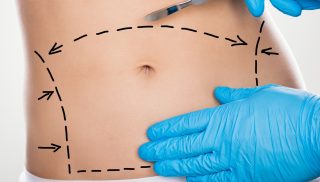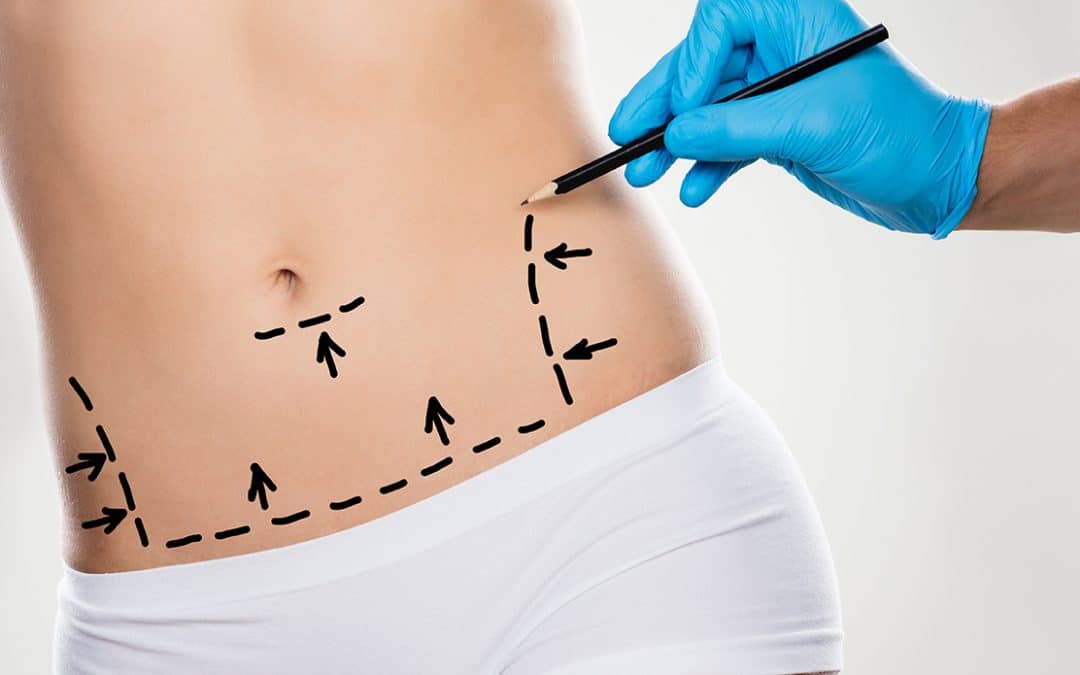Abdominoplasty in Islamabad
A tummy tuck is a cosmetic surgical procedure to improve the appearance of the abdomen.
During a tummy tuck (also known as abdominoplasty) excess skin and fat are removed from the abdomen. Connective tissue in the abdomen (fascia) usually is tightened with sutures as well. The remaining skin is then repositioned to create a more toned look.
You might choose to have a tummy tuck if you have excess fat or skin around the area of your belly button or a weak lower abdominal wall. A tummy tuck can also boost your body image.
Why it’s done
There are a number of reasons you might have excess fat, poor elasticity of the skin or weakened connective tissue in your abdomen. These include:
- Significant changes in weight
- Pregnancy
- Abdominal surgery, such as a C-section
- Aging
- Your natural body type
A tummy tuck can remove loose, excess skin and fat, and tighten weak fascia. A tummy tuck can also remove stretch marks and excess skin in the lower abdomen below the belly button. However, a tummy tuck won’t correct stretch marks outside of this area.
If you’ve previously had a C-section, your plastic surgeon might be able to incorporate your existing C-section scar into your tummy tuck scar.
A tummy tuck can also be done in combination with other body contouring cosmetic procedures, such as breast surgery. If you’ve had fat removed from your abdomen (liposuction), you may decide to have a tummy tuck because liposuction removes tissue just under the skin and fat but not any excess skin.
A tummy tuck isn’t for everyone. Your doctor might caution against a tummy tuck if you:
- Plan to lose a significant amount of weight
- Might consider future pregnancy
- Have a severe chronic condition, such as heart disease or diabetes
- Have a body mass index that’s greater than 30
- Are a smoker
- Had a previous abdominal surgery that caused significant scar tissue
How you prepare
Initially, you’ll talk to a plastic surgeon about a tummy tuck. During your first visit, your plastic surgeon will likely:
Review your medical history
Be prepared to answer questions about current and past medical conditions. Talk about any medications you’re taking or you have taken recently, as well as any surgeries you’ve had.
Tell your doctor if you are allergic to any medications. If your desire for a tummy tuck is related to weight loss, your doctor will likely ask detailed questions about your weight gain and loss.
Do a physical exam
To determine your treatment options, the doctor will examine your abdomen. The doctor might also take pictures of your abdomen for your medical record.
Discuss your expectations
Explain why you want a tummy tuck, and what you’re hoping for in terms of appearance after the procedure. Make sure you understand the benefits and risks, including scarring.
Keep in mind that previous abdominal surgery might limit your results.
Before a tummy tuck, you might also need to:
Stop smoking
Smoking decreases blood flow in the skin and can slow the healing process. In addition, smoking increases the risk of tissue damage. If you smoke, your doctor will recommend that you stop smoking before surgery and during recovery.
Avoid certain medications
You’ll likely need to avoid taking aspirin, anti-inflammatory drugs, and herbal supplements, which can increase bleeding.
Maintain a stable weight.
Ideally, you’ll maintain a stable weight for at least 12 months before having a tummy tuck. If you’re severely overweight, your doctor will recommend that you lose weight before the procedure. Significant weight loss after the procedure can diminish your results.
Take medication to prevent complications
Shortly before your tummy tuck, you’ll need to begin taking an anticoagulant to prevent blood clotting.
Arrange for help during recovery
Make plans for someone to drive you home after you leave the hospital and stay with you for at least the first night of your recovery at home.
What you can expect
- A tummy tuck is done in a hospital or an outpatient surgical facility.
- During a tummy tuck, you’ll be under general anesthesia — which makes you completely unconscious and unable to feel pain.
- In some cases, you might be given a pain-relieving medication and be moderately sedated (partially asleep).
Before the procedure
- There are a number of different procedures for a tummy tuck, depending on the extent of change you would like to see.
- During the typical tummy tuck, your plastic surgeon makes incisions to remove most of the skin and fat between your belly button and pubic hair in a horizontal oval or elliptical shape.
- Connective tissue (fascia) that lies over the abdominal muscles is then tightened with permanent sutures.
- Your plastic surgeon will then reposition the skin around your belly button. Your belly button will be brought out through a small incision and sutured in its normal position. The incision from hip to hip above the pubic hair will be stitched together and will leave a scar that falls along the natural crease within the bikini line.
- During the procedure, you might be given an antibiotic to prevent infection.
- The procedure typically takes about two to three hours.
After the procedure
- After a tummy tuck, your abdominal incision and belly button will likely be covered with surgical dressing.
- Small tubes might be placed along the incision site to drain any excess blood or fluid.
- Members of your healthcare team will help you walk as early as the first day after a tummy tuck to help prevent the formation of blood clots.
- You’ll likely feel moderate pain, which will be controlled by pain medication. It’s normal to have swelling in the surgical area.
- Drains might be left in place for several days after surgery. Your doctor or another member of your healthcare team will show you how to empty and care for your drains. You might need to continue taking an antibiotic as long as the drains are in place.
- Your surgeon might also prescribe a blood-thinning medication for a short time after your tummy tuck.
- You’ll wear a supportive abdominal garment (abdominal binder) for about six weeks after your tummy tuck. This helps prevent fluid buildup and provides abdominal support while you heal. Your doctor will explain how to care for your scar.
- For the first six weeks after a tummy tuck, you’ll need to be careful when moving around. You’ll also need to avoid positions that strain your incision line — such as quickly bending at the waist — to prevent the reopening of the wound.
- You’ll need to schedule regular follow-up visits. Ask your doctor how often you need to be seen.
Results
By removing excess skin and fat and strengthening your abdominal wall, a tummy tuck can give your abdomen a more toned and slimmer appearance. Tummy tuck results are usually long-lasting if you maintain a stable weight.




